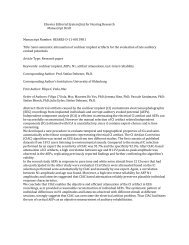Output frequency response function-based analysis for nonlinear ...
Output frequency response function-based analysis for nonlinear ...
Output frequency response function-based analysis for nonlinear ...
You also want an ePaper? Increase the reach of your titles
YUMPU automatically turns print PDFs into web optimized ePapers that Google loves.
N<br />
where c ¼ CEðHnð ÞÞ; FðjoÞ ¼ f1ðjoÞ; f2ðjoÞ; ...; fNðjoÞ . Note that f1ðjoÞ ¼H1ðjoÞ is the first-order<br />
n¼1<br />
GFRF, which represents the linear part of model (1) or (2).<br />
Eq. (5a) or (6) provide a more straight<strong>for</strong>ward analytical expression <strong>for</strong> the relationship between system<br />
time domain model parameters and system output <strong>frequency</strong> <strong>response</strong>. The system output <strong>frequency</strong> <strong>response</strong><br />
can there<strong>for</strong>e be analyzed in terms of any interested model parameters by using this explicit relationship.<br />
Hence, it can considerably facilitate the <strong>analysis</strong> and design of the output <strong>frequency</strong> <strong>response</strong> characteristics of<br />
<strong>nonlinear</strong> Volterra systems in the <strong>frequency</strong> domain. The main idea <strong>for</strong> the OFRF-<strong>based</strong> <strong>analysis</strong> proposed in<br />
this paper is that, given the model of a <strong>nonlinear</strong> system in the <strong>for</strong>m of model (1) or (2), CE(Hn( )) can be<br />
computed according to Eq. (5b) and jn(jo) can be obtained according to a numerical method which will be<br />
discussed later, thus the OFRF of the <strong>nonlinear</strong> system subject to any a specific input <strong>function</strong> can be<br />
achieved, which is an analytical <strong>function</strong> of <strong>nonlinear</strong> parameters of system model, and finally <strong>frequency</strong><br />
domain <strong>analysis</strong> <strong>for</strong> the <strong>nonlinear</strong> system can be conducted in terms of the specific model parameters of<br />
interest. In order to conduct an OFRF-<strong>based</strong> <strong>analysis</strong>, a general procedure is provided in this paper and<br />
several basic algorithms and related results are discussed. In many practical applications, the problems may be<br />
how some specific model parameters affect system output spectrum and what the effect is. There<strong>for</strong>e, some<br />
fundamental results are also developed to facilitate the application of the new method <strong>for</strong> this purpose.<br />
3. A general procedure <strong>for</strong> the determination of the OFRF<br />
In this section, a general procedure <strong>for</strong> the determination of the OFRF <strong>for</strong> a given model (1) or (2) is<br />
proposed, and some useful algorithms and techniques are provided.<br />
3.1. Computation of the parametric characteristics of OFRF<br />
This step is to derive c ¼ CEðHnð ÞÞ in Eq. (6).<br />
n¼1<br />
N<br />
ARTICLE IN PRESS<br />
X.J. Jing et al. / Mechanical Systems and Signal Processing 22 (2008) 102–120 105<br />
3.1.1. Determination of the largest order N<br />
To derive the parametric characteristics of OFRF, the first task is to compute the largest order, i.e., N, of<br />
the Volterra series expansion <strong>for</strong> the <strong>nonlinear</strong> system, which is basically determined by the significance of the<br />
truncation error in the Volterra series expansion of finite order. This can alternatively be done by evaluating<br />
the magnitude of the nth-order output <strong>frequency</strong> <strong>response</strong> Yn(jo). For example, the magnitude bound of<br />
Yn(jo) <strong>for</strong> the NARX model (2) can be evaluated by [29]<br />
Y nðjoÞ pan bn _ T<br />
n , (7)<br />
where an; _n are complex valued <strong>function</strong>s, and bn is a <strong>function</strong> vector of the system model parameters. For the<br />
detailed definitions <strong>for</strong> an; bn; _n refer to Jing et al. [29]. If the magnitude bound of a certain order of Yn(jo) is<br />
less than a predefined value (<strong>for</strong> instance 10 8 ), then the largest order N is obtained. It should be noted that<br />
the magnitude bound is a <strong>function</strong> of the model <strong>nonlinear</strong> parameters, there<strong>for</strong>e, the largest ranges of interest<br />
<strong>for</strong> each <strong>nonlinear</strong> parameter should be considered in the evaluation of |Yn(jo)|. 3.1.2. Determination of the parametric characteristics<br />
Once the largest order N is determined, the next step is to derive the parametric characteristics of GFRFs<br />
<strong>for</strong> the <strong>nonlinear</strong> system, i.e., CE(Hn( )) from n ¼ 2 to N, which will be used in the computation of<br />
N<br />
c ¼ CEðHnð ÞÞ. Note that CE(Hn( )) is computed in terms of the parameter vectors Cp;q ¼<br />
n¼1<br />
½cp;qð0; ...; 0Þ; cp;qð0; ...; 1Þ; ...; cp;qðK; ...; KÞŠ<br />
<strong>for</strong> some p,q in Eq. (5b).<br />
|fflfflfflfflfflffl{zfflfflfflfflfflffl}<br />
pþq<br />
Basically, <strong>for</strong> some specific parameters to be analysed <strong>for</strong> a system, CE(H n( )) can be recursively computed<br />
by Eq. (5b) with respect to these parameters of interest with the other non-zero <strong>nonlinear</strong> parameters being 1.

















